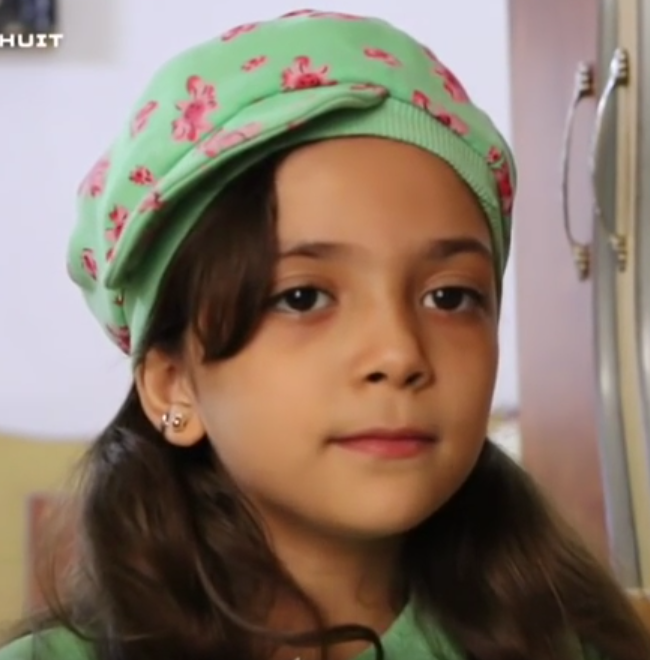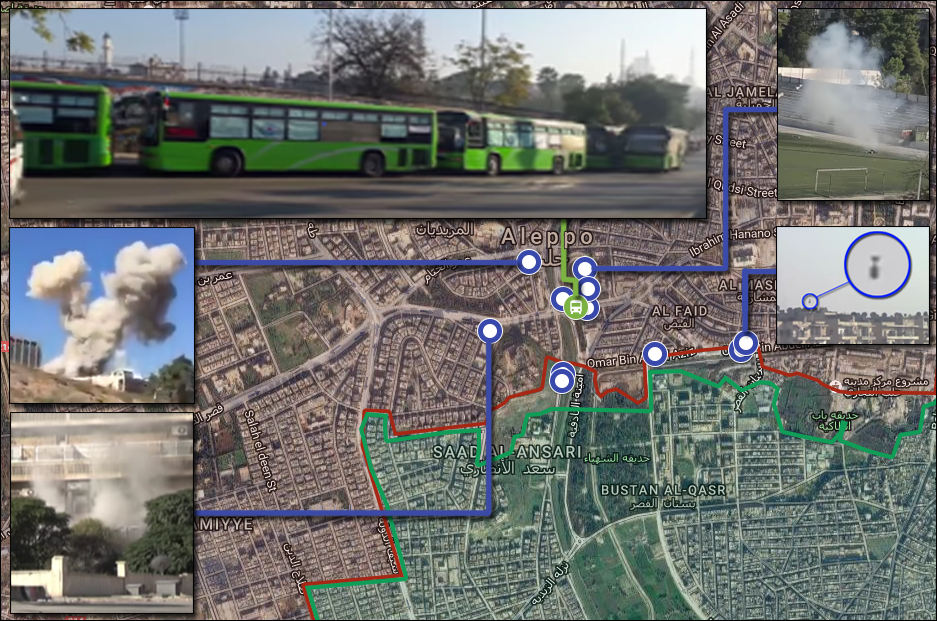The CL2 Before the Storm — Alleged Chemical Attacks in Aleppo in the Last Months of 2016
Warning: this report contains sensitive images. This article was written collaboratively with Bellingcat contributor Hady Al-Khatib, with additional contributions from Eliot Higgins.
Before the Syrian city of Aleppo was almost fully recaptured by Syrian government troops and aligned forces, the opposition-held part of the city witnessed one of the highest number of alleged chemical weapon attacks in the city since the Syrian war began. Chemical attacks in other areas of the Aleppo Governorate were also reported. Reports say chlorine barrel bombs and chlorine cylinders were dropped from the air on areas in East Aleppo. Furthermore, Syrian opposition groups and the so-called Islamic State (IS) have also been accused of using (improvised) chemical weapons, in particular chlorine and mustard gas. This report examines the open source information available, which are mostly related to chlorine attacks, but also include reports of mustard gas use. All times mentioned are in the local timezone (UTC+2), and YouTube upload times have been extracted using Amnesty International’s YouTube Data Viewer.
Incident 1: Al-Rashedeen district
Location: Al-Rashedeen district, Aleppo city
Date: October 30, 2016
Reported casualties: no information
Claimed chemical: chlorine gas
Alleged perpetrator: Syrian government
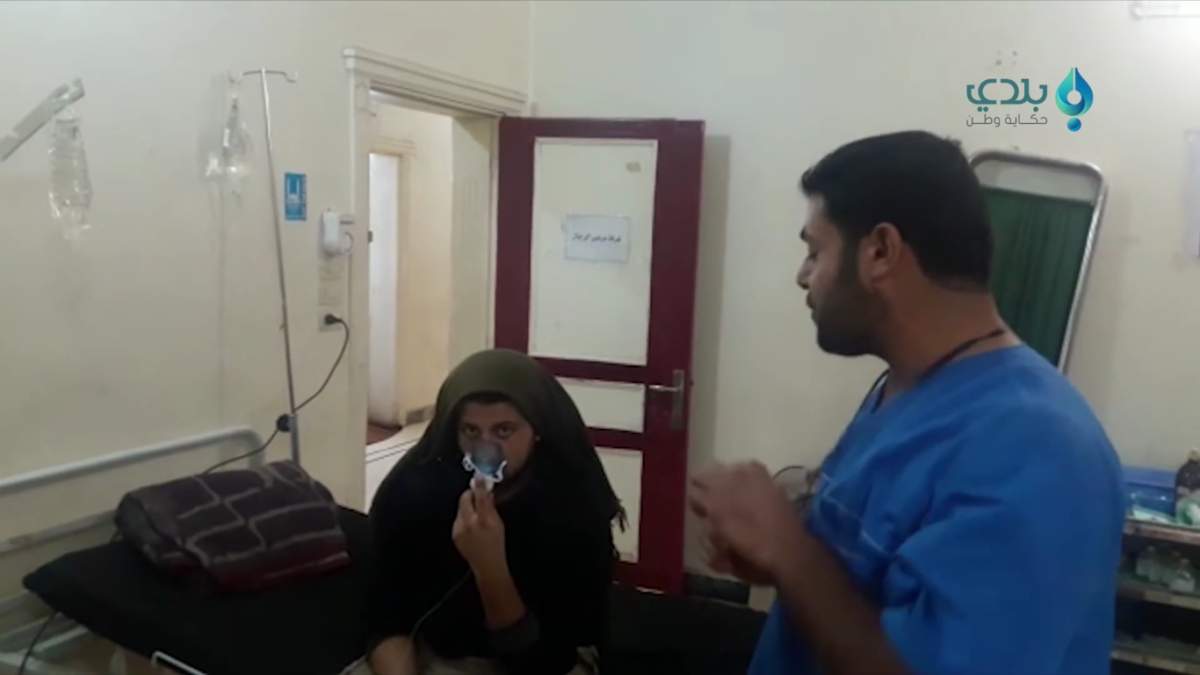
The first incident took place in late October 2016. A video was published by the pro-opposition Baladi News Network on YouTube and features two boys, their mouths covered with an oxygen mask. The boys, one of which is wearing green camouflage trousers, suffer from suffocation due to chlorine gas, according to the title of the video [archived].
Two medical staff can be seen, one dressed in blue, another dressed in green with a logo of “Ansaar Hospital”. The logo is identical to the logo used alleby Ansaar International e.V., a Salafist aid organisation from Germany that was founded in 2012. The medic dressed in blue says the two boys are injured due to a chlorine barrel bomb attack. A note on the open door says this is the room for male patients.
The 19-second long video was uploaded to YouTube on October 30, 2016, at 13:23 local time (UTC+2). The Amnesty International YouTube Data Viewer’s reverse image search of video stills did not show up any other videos. As only the interior of what appears to be a hospital is shown, the video cannot be geolocated. No remnants of the alleged weapon are filmed.
Incident 2: Khan Al-Assal
Location: Khan Al-Assal
Date: November 7, 2016
Reported casualties: no information
Claimed chemical: chlorine gas
Alleged perpetrator: Syrian government
A video shows several individuals being treated in what appears to be a field hospital. The video was uploaded to the YouTube channel of the Syrian Civil Defence in Aleppo, commonly known as “The White Helmets”, on November 7, 2016, at 11:24 local time (UTC+2). As of December 7, 2016, the video was viewed 107 times. No other uploads of the video could be found using the YouTube Data Viewer.
[archived]
According to the description video there were 32 injuries, including women and children, as a result of a chlorine barrel bomb which was dropped after midnight. It states that the Syrian Civil Defense transferred these civilians to field hospitals. One man and one woman can be seen with what appears to be an oxygen mask in the video, while a child’s arm is being treated.
The video is 31 seconds long, but it does only show the interior of what appears to be one of those field hospitals. For that reason, it is not possible to geolocate the video or the approximate area of the alleged attack in Khan Al-Assal.
The alleged chlorine barrel bomb attack was mentioned by only a handful of websites: The Online Citizen, Orient News, and Al-Sharq Al-Arabi.
Incident 3: Masaken Hanano and Ard Al-Hamra districts
Location: Masaken Hanano and Ard Al-Hamra districts, Aleppo city
Date: November 18, 2016
Reported casualties: 12 reported injured by Aleppo Civil Defense.
Claimed chemical: chlorine gas
Alleged perpetrator: Syrian government
The first video was uploaded by Al-Jisr News (Arabic: قناة الجسر الفضائية) on November 18, 2016, at 13:08 local time (UTC+2). A presenter stands in a street filled with rubble that was allegedly attacked by six chlorine barrel bombs. The video also features an interview with an individual from Syria Charity, a rescue team, who says that five chlorine barrel bombs were dropped by a helicopter. He claims that after the chlorine attacks, shelling of the area by pro-government forces continued and therefore they could not rescue victims. Nevertheless, he got out 11 children from the rubble.
A second video related to this incident was published by SMART News Agency on YouTube on November 18, 2016, at 13:27 local time (UTC+2). The same Syria Charity worker shown in video 1 is interviewed, this time saying four barrel bombs did not explode, and the area was later targeted by two missiles of the Syrian government, “which resulted in one casualty and five injured.”
A third video was published by the Aleppo Media Center (AMC) on its YouTube channel on November 18, 2016, at 21:08 local time (UTC+2). According to the title and the description of the video, it shows the remnants of a chlorine gas attack in the Masaken Hanano district of Aleppo city, said to be filmed by Abu Tim Al-Halabi (Arabic: أبو تيم الحلبي).
Two individuals are interviewed in the video. The first individual claims he was in a house when they heard an explosion, which they believed was a chlorine attack on a civilian area. Half a minute later into the video, an individual claims a helicopter attacked the Masaken Hanano and Ard Al-Hamra districts with five barrel bombs. “We smelled chlorine after the barrel explosions”, he says, “we rescued five people, we washed the injured with water.”
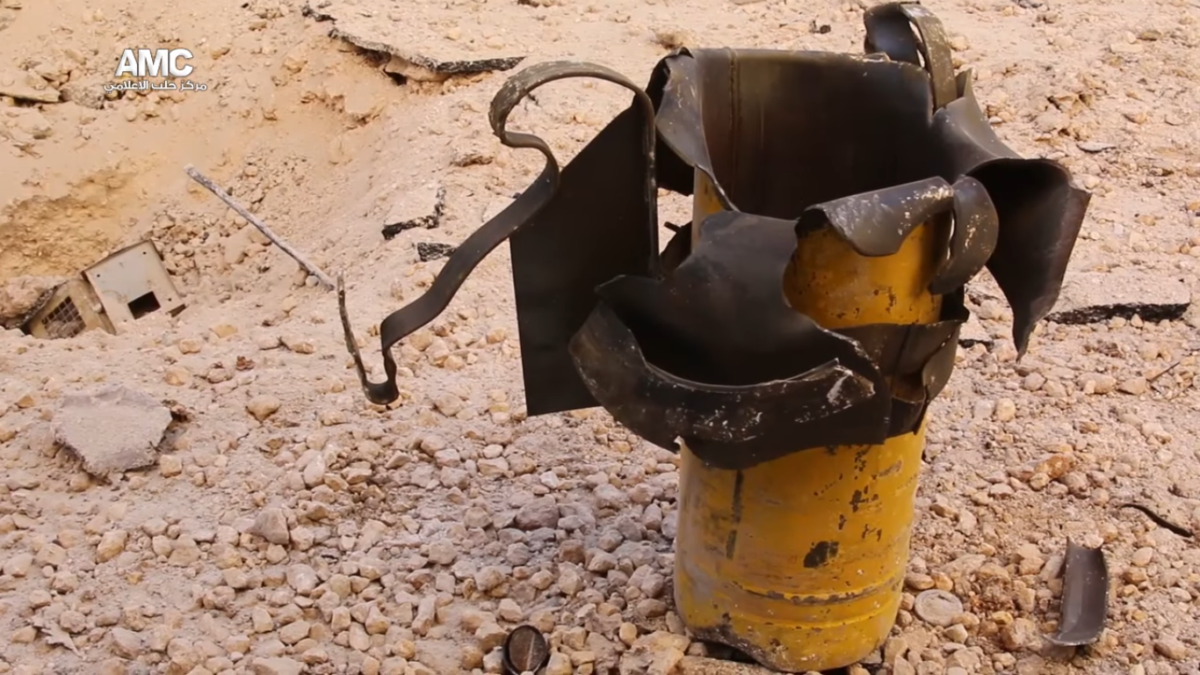
A metal remnant of the alleged weapon is shown, but no markings could indicate any further information. The weapon will further be examined in the discussion section below.
A young boy, wearing an oxygen mask in what appears to be a (makeshift) hospital, is interviewed in a fourth video related to the same incident in the Masaken Hanano district. “We were watching the helicopter and then it dropped a barrel and then it exploded very fast,” he says. “I was in a different street. We saw [very] yellow dust, when I came closer to the attacked site my chest started to hurt me.” Several other individuals, including a child, are also seen in the video, some wearing oxygen masks. The video was uploaded by pro-opposition Orient News on YouTube on November 18, 2016, at 21:08 local time (UTC+2).
Other photos from a weapon remnant taken on the same day and published by the Syrian Institute for Justice, , published Below are photos that has been shared with us through the Syrian Institute for Justice. While being shared with the claim that this showed a part of the above mentioned chlorine attacks, it is important to note that this a part of the Smerch rocket.
Incident 4: Al-Bab Road district
Location: Al-Bab road district near Al-Helwanyeh roundabout, Aleppo city
Date: November 20, 2016, around 16:30
Reported casualties: no information
Claimed chemical: chlorine gas
Alleged perpetrator: Syrian government
A video was published on AMC’s YouTube channel on November 23, 2016, at 18:11 local time (UTC+2). It shows the alleged remnants of an chlorine cylinder that was dropped on the Al-Bab Road district in Aleppo.
Othman, who claims to be a lawyer and activist working with the Syrian Institute for Justice and Accountability, says that a helicopter dropped a chlorine cylinder near the Al-Helwanyeh roundabout. He went to the location of impact to document the attack, and said he found a cylinder which is 1 meter in length and 25cm in width. The back of the cylinder was exploded, as a whole of around 50 cm indicates, Othman says. A logo of the Al-Baha Company for Caustic Chlorine Industry (BCC) can be seen on the cylinder. There is also a warning written in English on the cylinder that it contains gas.
Another video was published by the Syrian Institute for Justice and Accountability which shows the alleged attacked site.
The Bellingcat Investigation team geolocated the video above which was taken in Aleppo near Al-Helwanyeh round about.
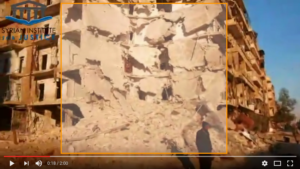
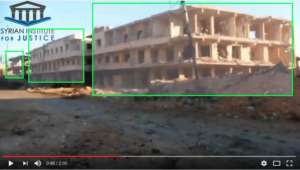
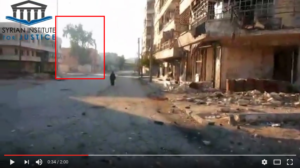
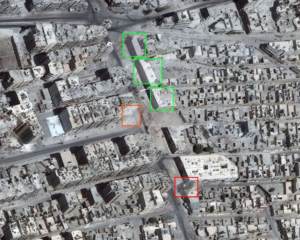
Two images below, published by the Syrian Institute for Justice and Accountability, show the BCC stickers on the chlorine cylinder. The images show the same cylinder as shown in the AMC video.
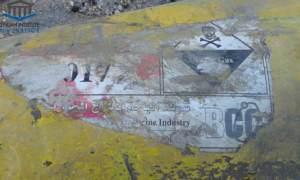
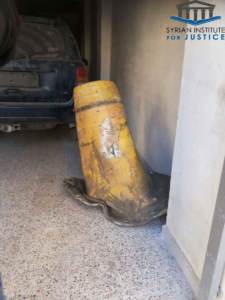
Incident 5: Al-Sakhour district
Location: Al-Sakhour district, Aleppo city
Date: November 20, 2016, around 01:00
Reported casualties: 6
Claimed chemical: chlorine gas
Alleged perpetrator: Syrian government
On the same day, another alleged chlorine attack took place in Aleppo, namely the Al-Sakhour district. A video published by AMC, since then deleted but archived, includes a witness report. “Yesterday night a barrel bomb was dropped into our neighbour’s house. We went to their house to see what happened and it appeared that the barrel had chlorine gies. Our neighbours died as a result of the chlorine.” The individual claims that the casualties had no injuries but died from suffocation. The bodies of his neighbour – one man, his wife, and their four children – were blue, he says.
Another individual tells his story, saying at around 01:00 AM they heard an explosion. They left the house and smelled chlorine gas. “My mom had breathing difficulties and my cousin had [not understandable] coming out of his mouth.” Later in the video, someone says his four friends died yesterday with their parents as result of the chlorine gas. This appears to be referring to the casualties mentioned in the first report.
A second video, filmed and published by Baladi News Agency, which was uploaded on November 20, 2016, at 10:04 local time. The video does not show up any other results before November 20, and shows four child casualties – likely to be the family mentioned above by the witness testimonies. While the video is of low quality (144p), the children indeed appear to have no injuries but have noticeable spots on their faces.
Two hours later after uploading, the Syrian Civil Defence YouTube channel uploaded the same video. Photos of the aftermath of the alleged attacked were also published by the group’s Facebook page. One of the photos shows a yellow cannister, which resembles the chlorine cylinders reportedly found at the earlier sites of alleged attacks.
A third video related to this incident was published by “thiqa agency” and shows the same location and gas cylinder as the Civil Defence photos. The video was uploaded on November 20, 2016, at 12:33 local time.
Additional photos from the same location and chlorine cylinder were published on AMC’s Facebook page.
Incident 6: Dahrat Al-‘Awwad district
Location: Dahrat Al-‘Awwad district, Aleppo city
Date: November 22, 2016
Reported injuries: no information
Claimed chemical: Chlorine Gas
Alleged perpetrator: Syrian government
This video was published by AMC which shows a helicopter and then greenish smoke rising from the Dahrat Al-Awad district in Aleppo.
The video was uploaded on November 22, 2016, at 18:27 local time, and shows two shots: one of a helicopter, and a second one of green smoke rising from. An explosion can be heard. No other information has been found about this alleged attack.
Incident 7: Al-Jazmati and Ard Al-Hamra districts
Location: Al-Jazmati and Ard Al-Hamra districts, Aleppo city
Date: November 23, 2016, around 20:00
Reported casualties: 1
Claimed chemical: chlorine gas
Alleged perpetrator: Syrian government
A first video was published by Al-Jisr News on November 24, 2016, at 19:37 local time, and their reporter Ahmad Abdulrahman is at the alleged attack location and interviews one individual, who says that “the smell is very strong from the moment [it] was dropped yesterday at 20:00 until now.”
Another video was published by AMC on November 24, at 20:22 local time. The video shows a group of media activists trying to document the alleged chemical attack which took place in Aleppo’s Al-Jazmati district.
One interviewed individual, at 1:05 in the video, says the following: “The chlorine barrel bomb was dropped yesterday at 20:00 in the evening. Our neighbour who is 55 years old has died as a result of the strong chlorine smell. No one was able to help her out.” Children were taken to medical points to be treated, he further claims. “We tried now to open the door were the barrel bomb was dropped to take it out but the smell is very strong so [we] couldn’t take it out from there.” A different individual says he woke up from the strong smell.”
A third video uploaded to Facebook shows civilian journalists near the alleged attack site, sharing their testimonies of what has happened. “We’re now in the Al-Jazmati district, it was attacked with chlorine gas. The smell of chlorine can still be felt all over this area. None of the rescue teams or the families were able to get inside the attacked site because of the strong smell.” They say the barrel bomb was dropped from the our, and claim a 55-year old woman has killed due to the chemical gases. “The chlorine barrel bomb is still inside the house.”
Other photos that have been posted online about a chlorine attack in Ard Al-Hamra. It should be noted yellowish smoke can be caused by conventional explosives, so while being shared as such this not a solid indicator of a chlorine attack taking place.
Besides the death of the woman, another ten injuries were reported by the Civil Defence in a Facebook post. A source within the Civil Defence tells Bellingcat that the injured were treated in a medical point in the Al-Sha’ar district.
Incident 8: Sheikh Maqsoud district
Location: Sheikh Maqsoud district in Aleppo
Date: November 25, 2016
Reported casualties: 6
Claimed chemical: mustard gas
Alleged perpetrator: Syrian opposition (Ahrar Al-Sham and Jahbat Fateh Al-Sham)
On November 25, 2016, the Sheik Maqsood district, mainly populated by Kurds and held by the YPG, was allegedly shelled by an “Islamist opposition group” or groups. A video was uploaded by Hawar News Agency (ANHA) on November 25, 2016, at 19:12, and shows a man and a woman suffering what seems to be suffocation. Other individuals, such as the children, were not in the house when the attack occurred, someone in the video says, and for that reason no other injuries were reported.
[archived]
Another video published by Hawar News Agency (ANHA) on November 25, 2016. It shows an interview with the hospital’s doctor. He says the following:
“I’m Dr Hussen from Khaled Fajer Hospital in Sheikh Maqsoud. Today there was shelling on our district and a result of it we received two suffocation cases. One of the cases got much better now. We suspect the use of chemical weapons in this attack because of saliva coming out of one injured mouths. Another case of a child was injured as a result of attack. We expect more cases to come as a result of this attack.”
ARA News reported the attack, allegedly conducted by Ahrar Al-Sham and Jabhat Fateh Al-Sham, killing at least six people while 15 individuals suffered from suffocation. “The wounded were immediately transferred to a makeshift hospital run by the Kurdish Red Crescent in Sheikh Maqsoud,” a local media activist told ARA News. Mihemed Hamke, the director of a hospital in the district told the agency that the initial investigation showed that the victims were exposed to a chemical agent. “The injured suffered from suffocation, skin burning and vomiting. These are obvious symptoms of exposure to mustard gas,” Mr. Hamke told ARA News.
No photos or videos from the weapon remnant have been published.
Incident 9: Al-Bab
Location: Al-Bab
Date: November 27, 2016
Reported casualties: none
Claimed chemical: chlorine gas
Alleged perpetrator: Islamic State
A video was tweeted on November 27, 2016, by “Ahmad Alkhatib”, showing symptoms of suffocation of what the uploader claims are four Free Syrian Army (FSA) fighters near Al-Bab in the Aleppo Governorate.
A different video [archived] was published on the Facebook page of the Independent Doctors Association (IDA), which claims to be “an independent humanitarian organization working to attain a standard level of health and social well-being for affected populations in Aleppo”. According to the Facebook post, nine injured civilians were treated at the Mohamed Wasim Muaz surgery hospital, which is also known as the Bab Al-Salameh hospital, as a result of a chlorine gas attack by IS. The attack reportedly targeted different locations in Al-Bab.
The following symptoms appeared to be seen in the video: coughing, blue skin, breathing difficulties, as well as described pain in the lungs. No casualties were reported.
A photo was also published by IDA [archived], saying it shows their nine civilians were treated after IS attacked civilian around the city of Al-Bab. The main symptoms of the chemical attack were coughing, difficulty of breathing due to irritation of the lungs and airways, and swellings on the skin, IDA writes.
Incident 10: Al-Kalaseh district
Location: Al-Kalaseh district in Aleppo
Date: December 8, 2016
Reported casualties: no information
Claimed chemical: chlorine gas
Alleged perpetrator: Syrian government
A photo [archived] showing the alleged attack site was published by Aleppo Today’s Facebook page on December 8, 2016. We could not find much more information on this incident.
Incident 11: Bustan Al-Qaser and Al-Fardous districts
Location: Al-Fardous district in Aleppo
Date: December 8, 2016
Reported casualties: no information
Claimed chemical: chlorine gas
Alleged perpetrator: Syrian government
The Syrian Institute for Justice published a photo claiming to show the chlorine gas cylinder, which resembles the yellow cylinders reportedly seen at earlier incidents. This attack happened in Bustan Al-Qaser district during the night on Dec 08, 2016.
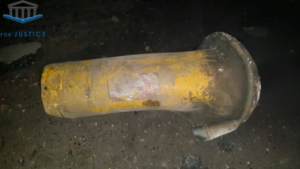
On the Ground News’s reporter Bilal also published a video showing the alleged aftermath of the chlorine gas attack, which shows a yellowish or greenish mist. Again, it should be noted yellowish smoke can be caused by conventional explosives, so this is not a solid indicator of a chlorine attack taking place.
Regime launches chlorine gas attack in Firdous, Aleppo. The yellow-green mist can clearly be seen. Please retweet! pic.twitter.com/ET4Jh0pFdU
— On the Ground News (@OgnNews) December 8, 2016
[archived]
Incident 12: Bustan Al-Qasr district
Location: Bustan Al-Qaser district in Aleppo
Date: December 10, 2016
Reported injuries: no information
Claimed chemical: chlorine gas
Alleged perpetrator: Syrian government
On December 10, 2016, a similar yellow cylinder was filmed after an alleged chlorine gas attack in the Bustan Al-Qasr districts, SMART News Agency’s video shows. The video was uploaded on December 10, 2016, at 18:22. The first shot suggests that the chlorine cylinder was dropped from an aircraft using a parachute.
https://youtu.be/d9O-9eKSfPQ?t=35s
Photos from the victims from the alleged chlorine gas attack were published by the Bustan Al-Qasr Medical Center’s Facebook page.
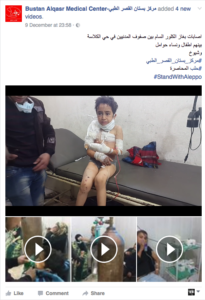
Discussion
Out of twelve reported chemical attacks, the Syrian government was accused in ten instances, IS once, and the combination of Ahrar Al-Sham and Jabhat Fateh Al-Sham also once. By far most incidents claim chlorine gas was used, a chemical which is not covered by the Organisation for the Prohibition of Chemical Weapons (OPCW) as it is used in key industries such as water treatment. One incident that was reported to have taken place in Sheikh Maqsoud, claimed mustard gas was used.
However, it appears that the Syrian government has dropped out barrel bombs containing chlorine gas cylinders and modified gas cylinders above opposition-held parts of Aleppo. On several gas cylinders documented after such alleged attacks, the name of a Jordanian company could be read. The company confirmed it indeed uses the chlorine and other chemicals for the sterilisation of water, and stated to Ennabaladi that it has nothing to do with weapon production. The company claims it has stopped export to Syria since the uprising began in 2011.
Regarding weapons production, it is worth noting that the chlorine cylinder shown in the Masaken Hanano incident appears to have a structure added to the exterior of the cylinder, adding what appears to be at least one tailfin. Damage to the front of the cylinder suggests an explosive was used to breach the cylinder. A long metal strip can be seen, which may have been extended to the end of the barrel bomb to hold the fuze, detonator and/or explosive charge in place. The chlorine cylinder resembles other cylinders used in alleged attacks, such as the October 1, 2016, alleged attack in Kafr Zita, and more recently on November 18, 2016, in Aleppo’s Masaken Hanano district, as shown below.
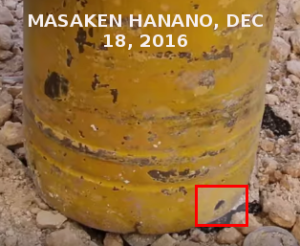
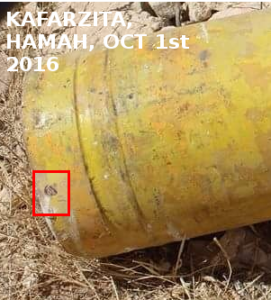
Unlike the vast majority of chlorine attacks reported before the Autumn of 2016 the recent chlorine attacks detailed above do not appear to use the same external casing used by explosive barrel bombs. In the above examples there is no noticeable external structures present on the chlorine cylinders. In the one exception, the metal structure appears to be an attempt to convert a chlorine cylinder into a free fall bomb, adding tail fins, and possibly a fuze/detonator structure to the cylinder. As of yet, this modification appears unique in all cases of reported chlorine attacks in Syria. This change, where previously the casing of explosive barrel bombs were used to house the chlorine cylinders, maybe be the result of the destruction of a suspected barrel bomb factory in the summer of 2016. However, there is not enough data to draw a solid conclusion at this point.
*Correction*, August 12, 2019: A previous version of this article referred to an “attack location”. This should have been “alleged attack location”.
